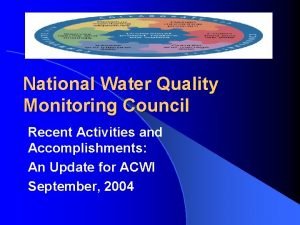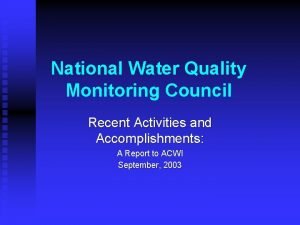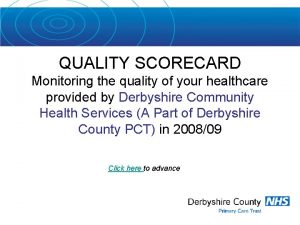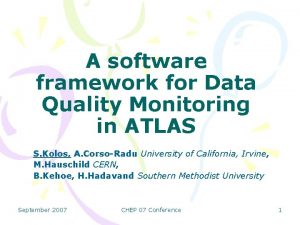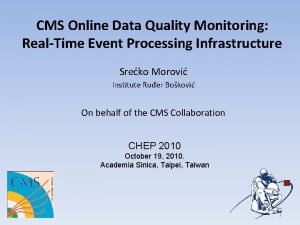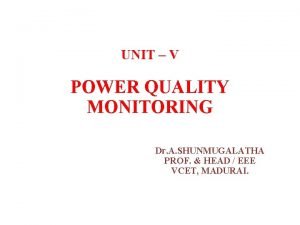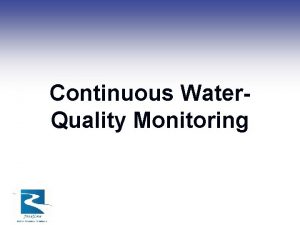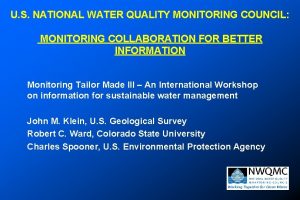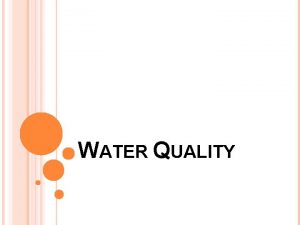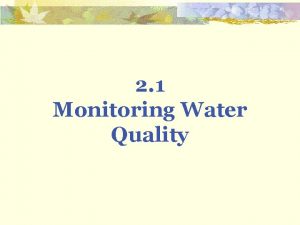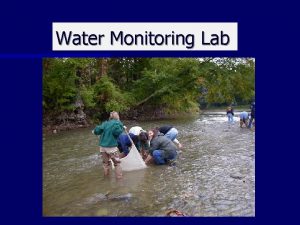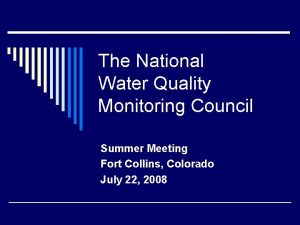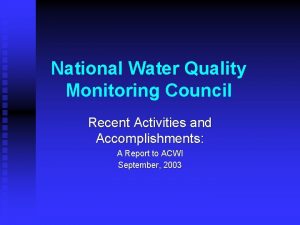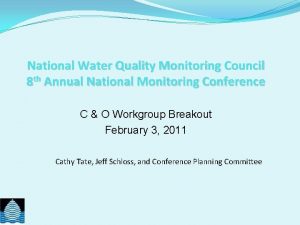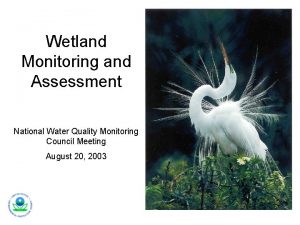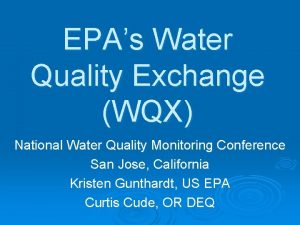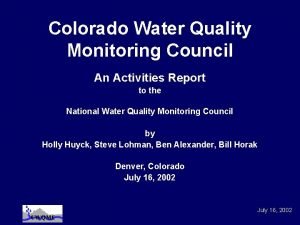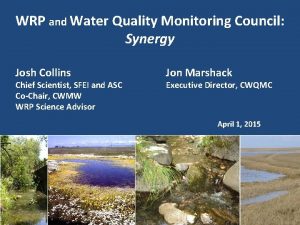National Water Quality Monitoring Council 4 th National






















- Slides: 22

National Water Quality Monitoring Council 4 th National Monitoring Conference Application of Automated Systems for Clean Composite Sampling Jamie Heisig-Mitchell, Danny L. Barker & Norman E. Le. Blanc Hampton Roads Sanitation District Virginia Beach, Virginia

Importance of Data Quality v Data used to monitor regulatory compliance v Trace metal data may easily be compromised by contamination in sampling and analysis v Use of clean techniques in sampling and analysis is critical to obtaining representative and accurate data

Evolution of Clean Metals Sampling System v In recognition of need for collecting clean metals, state suspended final effluent metals monitoring for 2 years v Delay provided time to develop clean sampling techniques & analytical procedures v HRSD developed a sampling system which could provide representative automated composite samples for trace metals



Pro’s and Con’s of System v Advantages: v Reduces sample handling & potential contamination v Decreases labor and expendable equipment costs v Disadvantages: v Large footprint v Use in collection of dissolved metals can be controversial

Dissolved Metals Controversy v 40 CFR 136 – Table II v “Samples should be filtered immediately on-site before adding any preservative for dissolved metals” v “Sample preservation should be performed immediately upon sample collection. For composite samples each aliquot should be preserved at the time of collection. When the use of an automated sampler makes it impossible to preserve each aliquot, then chemical samples may be preserved by maintaining at 4ºC until compositing and sample splitting is complete”

How do states handle this? v Most states seem to incorporate 40 CFR 136 Table II language directly into regs – some do not specifically address issue while others, interpret the language to preclude the use of automated samplers for the collection of dissolved metals v At least one state indicates that “samples for dissolved metals must be filtered at time of collection or within 24 hours of collection and prior to preservation”

Effect of Collection on DS Metals v Study designed to specifically address collection method and its affect on dissolved metals v Also addressed automated collection of mercury using EPA 1631 and the use of alternate container compositions v Examined effect of prolonged delay between the end of the composite and sample splitting

Study Difficulties v Needed to obtain quantifiable numbers v Needed to sample from free-flowing effluent source so metals states would not artificially achieve equilibrium v Needed consistent sample source so that manual aliquots and automated aliquots were collected from same slug of effluent





Study Plan v Automated aliquots collected using our clean sampling system v Intermediate samples kept on ice for duration of composite period v Manual aliquots collected using our clean system for grab samples v Wastewater collected in flow-through barrel – influent and effluent valves closed 15 minutes prior to aliquot collection to allow volume to thoroughly mix







Conclusions Though the power of the test comparing the 3 plants was low, the individual plant results indicate that there is no difference in dissolved metals concentrations in samples collected via automated and manual aliquots v Differences in concentrations seemed to relate more to sampling and analytical variability – there were no evident trends v Plan to conduct several more rounds of data collection at the same plants to yield more conclusive data v
 National water quality monitoring council
National water quality monitoring council National water quality monitoring council
National water quality monitoring council Nwqmc conference
Nwqmc conference National water quality monitoring conference
National water quality monitoring conference Water and water and water water
Water and water and water water Bronx council for environmental quality
Bronx council for environmental quality Nrbpt
Nrbpt Quality monitoring scorecard
Quality monitoring scorecard Quality monitoring scorecard
Quality monitoring scorecard Dqmf
Dqmf Wdqms
Wdqms Real time data quality monitoring
Real time data quality monitoring Permanent power quality monitoring equipment
Permanent power quality monitoring equipment California urban water conservation council
California urban water conservation council Reservoir water level monitoring system
Reservoir water level monitoring system Reservoir storage monitoring system
Reservoir storage monitoring system Quality assurance vs quality control
Quality assurance vs quality control Pmp quality vs grade
Pmp quality vs grade Pmp gold plating
Pmp gold plating Define quality assurance in nursing
Define quality assurance in nursing Compliance vs quality
Compliance vs quality Concepts of quality
Concepts of quality Which of the gurus would be the father of quality control?
Which of the gurus would be the father of quality control?
